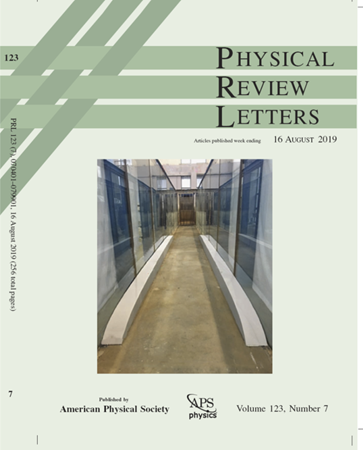Quantum Geometry and the Electric Magnetochiral Anisotropy in Noncentrosymmetric Polar Media
IF 9
1区 物理与天体物理
Q1 PHYSICS, MULTIDISCIPLINARY
引用次数: 0
Abstract
The electric magnetochiral anisotropy is a nonreciprocal phenomenon accessible via second harmonic transport in noncentrosymmetric, time-reversal invariant materials, in which the rectification of current, 𝐈, can be controlled by an external magnetic field, 𝐁. Quantum geometry, which characterizes the topology of Bloch electrons in a Hilbert space, provides a powerful description of the nonlinear dynamics in topological materials. Here, we demonstrate that the electric magnetochiral anisotropy in noncentrosymmetric polar media owes its existence to the quantum metric, arising from the spin-orbit coupling, and to large Born effective charges. In this context, the reciprocal magnetoresistance 𝛽𝐁2 is modified to 𝑅(𝐼,𝑃,𝐵) = 𝑅0[1 +𝛽𝐵2 +𝛾±𝐈 ·(𝐏 ×𝐁)], where the chirality dependent 𝛾± is determined by the quantum metric dipole and 𝐏 is the polarization. In 2D, we predict a universal scaling 𝛾±(𝑉) ∼𝑉−5/2, which we compare to available phase sensitive, second harmonic transport measurements on hydrothermally grown tellurium films under applied gate voltage, 𝑉. The control of rectification by varying 𝐈, 𝐏, 𝐁, and 𝑉, demonstrated in this work, opens up new avenues for the building of ultrascaled complementary metal-oxide-semiconductor circuits.非中心对称极性介质中的量子几何和电磁手性各向异性
电磁手性各向异性是一种非互易现象,可以通过非中心对称的时间反转不变性材料中的二次谐波输运来实现,其中电流的整流𝐈可以通过外部磁场来控制。量子几何表征了希尔伯特空间中布洛赫电子的拓扑结构,为拓扑材料的非线性动力学提供了强有力的描述。在这里,我们证明了非中心对称极性介质中电磁手性各向异性的存在是由于自旋-轨道耦合引起的量子度量和大玻恩有效电荷。在这种情况下,磁电阻的倒数时延时延时延时延时延时延时延时延时延时延时延时延时延时延时延时延时延时延时延时延时延时延时延时延时延时延时延时延时延时延时延时延时延时延时延时延时延时延时延时延时延时延时延时延时延时延时延时延时延时延时延时延时延时延时延。在二维中,我们预测了一个普遍尺度的±s (s)²(s)²(s)²(s)²(s)²(s)²(s)²(s)²,我们将其与施加栅极电压(s)²下水热生长碲薄膜的相敏、二次谐波输运测量结果进行了比较。在这项工作中,通过改变𝐈,𝐏,,和来控制整流,为建立超尺度互补金属氧化物半导体电路开辟了新的途径。
本文章由计算机程序翻译,如有差异,请以英文原文为准。
求助全文
约1分钟内获得全文
求助全文
来源期刊

Physical review letters
物理-物理:综合
CiteScore
16.50
自引率
7.00%
发文量
2673
审稿时长
2.2 months
期刊介绍:
Physical review letters(PRL)covers the full range of applied, fundamental, and interdisciplinary physics research topics:
General physics, including statistical and quantum mechanics and quantum information
Gravitation, astrophysics, and cosmology
Elementary particles and fields
Nuclear physics
Atomic, molecular, and optical physics
Nonlinear dynamics, fluid dynamics, and classical optics
Plasma and beam physics
Condensed matter and materials physics
Polymers, soft matter, biological, climate and interdisciplinary physics, including networks
 求助内容:
求助内容: 应助结果提醒方式:
应助结果提醒方式:


